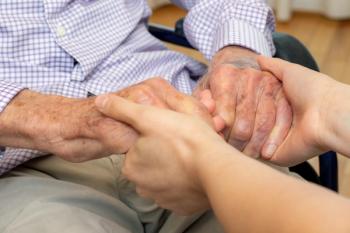
Where telehealth can help patients, and providers, avoid in-person care
Many patients who had a virtual appointment didn’t need to go to a doctor’s office, an Epic study found. Jackie Gerhart of Epic talks about the ways telehealth can expand access.
Jackie Gerhart is aiming to change some misconceptions around
Despite concerns that telehealth visits typically lead to in-person visits, Gerhart, vice president of clinical informatics at Epic, said that’s not exactly the case.
An Epic study of a host of specialties indicated that in most cases, no in-person appointment was needed for a follow-up visit within the next three months.
“Less than half of the time people actually needed a follow up in person,” Gerhart says. And she tells Chief Healthcare Executive that it didn't come as a shock to her.
“I expected to find it. But I think it's surprising to most people,” she says.
The results were especially noteworthy in mental health and psychiatry, where only 15% of patients required an in-person visit after a telehealth visit.
“Telehealth has been amazing throughout the pandemic in being able to provide access to care, but also in being able to give the care that otherwise may have otherwise been done in the exam room setting, and actually give that care in a way that's not only more convenient, but maybe even gets to a diagnosis or a plan of care faster than it might have taken if you had to wait for an in-person visit,” Gerhart said.
Gerhart spoke with Chief Healthcare Executive about telehealth, its growing use in some specialties, and how providers can use telehealth access to healthcare. (See part of our conversation in this video. The story continues below.)
- Read more:
Telehealth finds receptive ear in Congress
More doctors are using telehealth, at least on an occasional basis.
Some health leaders have questioned if telehealth will reduce in-person visits or simply be duplicative, with patients needing to go see a doctor shortly after a virtual visit.
But in 33 specialty areas reviewed in the Epic analysis, most didn’t need a follow-up visit within 90 days. Only three specialties saw more than half of patients require an in-person visit afterwards. Epic examined more than 35 million telehealth visits between March 1, 2020 and May 31, 2022.
“We've been surprised at how many different conditions we can take care of through telemedicine that we hadn't thought of doing before,” Gerhart said.
“if the evaluation and treatment that you can have for a given disease could be done without seeing the person face to face, then telemedicine seems to be an effective way to do it.”
Advantages for mental health
Mental health professionals have touted telemedicine as a vital tool to expand access to more patients, partly due to the shortage of mental health professionals. Over half of all U.S. counties are without a practicing psychiatrist, according to the
There are promising indicators that telehealth is effective in behavioral health. Researchers with the Centers for Disease Control and Prevention and the National Institutes of Health found
Many patients struggling with mental health issues welcome telehealth appointments for a variety of reasons, Gerhart says.
“If you happen to be in a depressed state or you, for whatever reason, have transportation troubles, it is just easier to get to a telemedicine visit via your mobile device,” she says.
Some patients also are extremely private and don’t want to be seen going inside the office of a mental health services provider.
“Telehealth can often be more discreet where you can just go into a private room and quickly join in and then go back with the rest of your day,” Gerhart says.
A patient disclosing a difficult subject may also feel more comfortable talking inside their own home. And telehealth visits offer advantages for both the patient and the practitioner.
“There are benefits from the home for a few different reasons,” Gerhart says. “One, it might be more comfortable. You might feel more at ease. You have other people and other signs in your room that help the practitioner know what else is going on in your life even if you didn't bring it up.” The provider could see a child or a pet for instance, or even gain some insights from photos on the wall.
Group appointments can also be easier via telehealth, Gerhart says.
“Two people could just sit together from their home as well,” she says. “So I think the comfort of being able to explore even more detail into a person's life via telehealth is really neat.”
Telehealth appointments can offer more comfort for kids, who sometimes find going to a sterile physician’s office - the place they get shots - to be a scary proposition. And some children enjoy talking via video on a mobile phone or tablet.
“It almost attracts them to be more engaged,” she said.
Kids can enjoy another perk of seeing a doctor from home. “You don’t have to get out of your princess pajamas,” Gerhart says.
Going virtual
In the Epic analysis, some areas saw very few patients go to a follow-up appointment. In genetics, only 4% of patients required an in-person appointment (the lowest in the analysis), while only 10% of those in nutrition needed to see a doctor afterwards within 90 days.
Other specialties with a low-level of patients who needed an in-person visit following a telehealth appointment include endocrinology (14%), neurology (16%), GI (20%), infectious diseases (21%), and rheumatology (21%).
"It's clear that there's certain specialties that can rely upon telemedicine a little bit more heavily than others,” Gerhart says.
Some patients are going to need in-person visits. Perhaps not surprisingly, the highest rate of in-person visits following a telehealth appointment came in obstetrics (90%).
Other specialties regularly needing an in-person appointment following use of telehealth include fertility (54%), geriatrics (50%), surgery (43%), sports medicine (43%), and cardiology (42%).
But telehealth has proven to be especially useful for older patients, even though some skeptics have thought seniors wouldn't be tech savvy enough to engage in virtual appointments.
“That's another myth that we have been trying to bust, that people over a certain age can’t use technology,” Gerhart says.
Seniors are using technology to have video chats with grandchildren and use apps to board airplanes. “It’s already ingrained in them,” she says.
Telehealth appointments are also appealing to seniors with mobility issues or those who don’t relish long drives to a provider.
“Quite frankly, it's pretty frustrating if you can't get the same level of autonomy and access to service in a field that is so important and relevant, like health care, especially as you age,” Gerhart says.
Preferences for patients and providers
Since only a small number of patients needed follow-up in some specialties, will there be a shift in some areas of medicine where telehealth replaces face-to-face care?
Gerhart says it depends on several factors, including the physicians having the right data to make an accurate diagnosis virtually.
But she also said it depends on the comfort level of the clinician in using telehealth.
“It is not just about what preferences the patient has,” Gerhart says. “It's also about how a provider can provide the best care.”
“There are physicians and clinicians that feel more comfortable having the person come into the exam room, just like there's patients that feel more comfortable being seen in the exam room,” she adds.
For doctors to succeed with telehealth, they need to be comfortable guiding a patient and explaining medical information in a virtual visit.
“If you're able to communicate better with the patient, they will have a better outcome,” Gerhart says. “Depending on your communication skills, if you feel like in your specialty, you can communicate those via telehealth, then it may be effective. But if you don't feel you're comfortable doing that, then it may be less effective.”
For doctors who don’t relish telehealth appointments, health systems and practices should view it as “a learning opportunity,” she says.
“It seems more like an opportunity to help people grow in their own practice, and hopefully help serve their patients better,” Gerhart says.
Healthcare leaders should embrace and expand the use of telehealth, Gerhart says.
“As we've seen from the data, especially as supported in this study, it is something that patients enjoy,” Gerhart says. “But more importantly, that they don't need another follow up afterwards. And I think that was the big question going into this was, is this something that can kind of stand on its own, that is able to provide care without needing to do duplicative care? And I feel like this study shows that.”








































